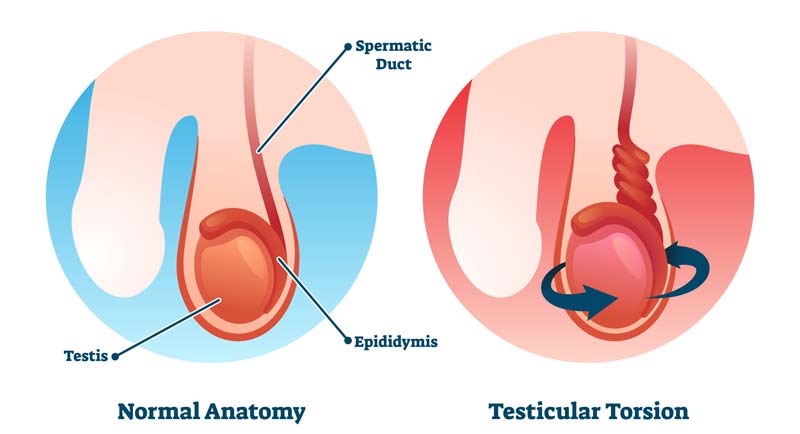What is Testicular Torsion?
Testicular torsion is when the spermatic cord twists. The spermatic cord provides blood flow to the testicles. This twisting can lead to a reduction or even a complete blockage of blood flow to the affected testicle. It is considered a medical emergency because, without prompt treatment, the lack of blood flow can cause severe damage to the testicle.
Symptoms of Testicular Torsion
The main symptom of testicular torsion is sudden and severe pain. Usually, the pain is on one side only and can be excruciating. Other symptoms may include:
1. Swelling and Redness: The affected testicle may become swollen and appear red or darker in color compared to the other testicle.
2. Abdominal Pain: Some individuals with testicular torsion might experience abdominal pain, which can be mistaken for a stomach issue.
3. Nausea and Vomiting: The pain from testicular torsion can sometimes lead to nausea and vomiting.
4. High Testicle Position: The affected testicle might be positioned higher than usual within the scrotum due to the twisting of the spermatic cord.
Identifying these symptoms and seeking medical attention promptly is essential for a positive outcome. If it happens outside of regular office hours, seek care at an emergency room or urgent care facility.
Causes of Testicular Torsion
This often occurs without a specific cause, but certain factors can increase the risk:
1. Age: It is more common in males between puberty and early adulthood.
2. Physical Activity: Vigorous physical activities, especially those involving sudden movements, can lead to testicular torsion.
3. Anatomy: Some individuals are predisposed if their testicles are attached more loosely to the scrotum.
4. Previous Torsion: If someone has had testicular torsion in one testicle before, they might be at a slightly higher risk for it happening again.
Diagnosis
Prompt diagnosis and treatment are vital to prevent further damage. A healthcare provider will likely perform the following:
1. Physical Examination: The doctor will examine the scrotum for swelling, redness, and testicle position.
2. Ultrasound: This imaging test can help confirm the diagnosis by showing the blood flow to the testicle. Reduced blood flow can indicate torsion.
3. Doppler Ultrasound: This specialized ultrasound can provide information about blood flow in real time, helping to assess the severity of torsion.
Treatment
Upon diagnosis treatment should be done as quickly as possible to restore blood flow and prevent irreversible damage to the testicle. The primary treatment approach is surgical intervention, which typically involves:
1. Manual Detorsion: The doctor may attempt to manually untwist the spermatic cord by rotating the testicle back to its normal position. This can temporarily relieve the torsion and restore blood flow, but surgery is usually needed afterward to secure the testicle and prevent future torsion episodes.
2. Surgery (Orchiopexy): A surgical procedure called orchiopexy is performed to secure the testicle in its proper position and prevent future episodes of torsion. During this surgery, the affected testicle is stitched to the surrounding tissues to prevent it from twisting again. This procedure is often done as soon as possible after diagnosis.
After surgery, follow-up appointments will be scheduled to monitor the healing process and ensure there are no complications.
Recovery
Recovery from testicular torsion and its surgical treatment varies depending on the individual and the severity of the torsion. In most cases, men can expect:
1. Pain Management: Pain and discomfort are expected after surgery. Pain relievers prescribed by the doctor can help manage this discomfort during recovery.
2. Activity Restrictions: Physical activities and strenuous exercises may need to be limited to allow proper healing and prevent complications.
3. Follow-Up Care: Regular follow-up appointments with the healthcare provider are important to monitor the healing process and ensure there are no complications.
The outlook is generally favorable with timely treatment. Most individuals can regain normal function and maintain their fertility if the condition is promptly addressed.
Frequently Asked Questions (FAQs)
How do I check myself for testicular torsion?
You can gently feel the affected testicle to feel for swelling or other changes from normal. Seek medical attention immediately if you notice sudden pain, swelling, or other unusual symptoms.
What does testicular torsion feel like?
This condition often causes intense and sudden pain in the scrotum, usually on one side. The pain might be accompanied by swelling, redness, and possible nausea or vomiting due to the severity of the pain.
How long does testicular torsion last?
Testicular torsion is a medical emergency that requires prompt intervention. If not treated quickly, it can lead to irreversible damage. Testicular torsion will not go away on its own.
How to fix testicular torsion at home?
Testicular torsion cannot be fixed at home. It requires a physician to diagnose it and provide treatment, usually involving surgery, to untwist the spermatic cord and restore blood flow to the affected testicle.
Can testicular torsion happen again after surgery?
While surgery (orchiopexy) is usually done to secure the testicle and prevent future torsion, it can occur again. An orchiopexy reduces the risk of recurrence. It can also happen in the other testicle.


